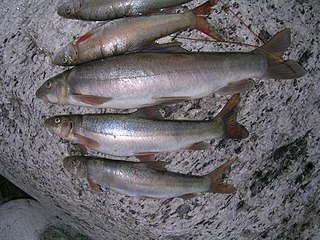
Acrossocheilus is a genus of ray-finned fishes in the family Cyprinidae, native to freshwater in China, Taiwan, Laos, and Vietnam. They are fairly small, no more than 30 cm (1 ft) in standard length.

Dian Lake, also known as Dianchi, Dianchi Lake, Lake Dian and Kunming Lake, is a fault lake located on the Puduhe-Xishan fault in Kunming, Yunnan, China at 24°23′–26°22′ N, 102°10′–103°40′ E. Its nickname is the "Sparkling Pearl Embedded in a Highland". It is the model for the Kunming Lake in Beijing's Summer Palace. Its name is the source of Yunnan's Chinese abbreviation 滇.

Schizothorax is a genus of cyprinid fish found in southern and western China, through northern South Asia (Himalaya) and Central Asia, to Iran, with a single species, S. prophylax, in Turkey. They are primarily found in highland rivers, streams and lakes, although a few species occur in lower-lying locations, like Lake Balkhash and lakes of the Sistan Basin. Their scientific name means "cloven-breast", from Ancient Greek schízeïn (σχίζειν) 'to cleave' and thórax (θώραξ) 'breast-plate'. The western species are typically referred to as marinkas from their Russian name marinka (маринка), while the eastern species are usually called snowtrout. Although they do resemble trouts in habitus this is merely due to convergent evolution and they are by no means closely related apart from both being Teleostei: Cyprinids are in the teleost superorder Ostariophysi, while trouts are in the superorder Protacanthopterygii. Their ancestors must thus have diverged as early as the Triassic, more than 200 million years ago.
Sinocyclocheilus is a genus of freshwater fish in the family Cyprinidae that is endemic to Guangxi, Guizhou and Yunnan in China. Almost all of its species live in or around caves and most of these have adaptions typical of cavefish such as a lack of scales, lack of pigmentation and reduced eyes. Several species have an unusual hunchbacked appearance and some of the cave-dwellers have a "horn" on the back, the function of which is unclear. In contrast, the Sinocyclocheilus species that live aboveground, as well as a few found underground, show no clear cavefish adaptions. They are relatively small fish reaching up to 23 cm (9.1 in) in length. The individual species have small ranges and populations, leading to the status of most of the evaluated species as threatened. Many species populations in the genus have yet to be evaluated by the IUCN.

Light's bitterling is a temperate freshwater fish belonging to the subfamily Acheilognathinae of the family Cyprinidae. It originates in Russia and China, from the Amur River basin to southern China. It was originally described as Pseudoperilampus lighti by H.W. Wu in 1931.
Discherodontus is a genus of small cyprinid fishes found in rivers and streams in Mainland Southeast Asia and Yunnan in China.
Oreonectes is a genus of fish in the family Nemacheilidae found in the rivers and caves of Asia. Many of these species are troglobitic.

Fuxian Lake is a body of water in Yunnan Province, China. It stretches through Chengjiang, Jiangchuan and Huaning Counties, spanning an area of 212 square kilometers. It is the third-largest lake in Yunnan, after Dian Lake and Erhai Lake, and the deepest, at 155 meters. It is the third-deepest fresh water lake in China, after Tianchi and Kanas Lake.
Schizothorax beipanensis is a species of ray-finned fish in the genus Schizothorax which is found in the upper tributaries of the Beipan River in China.
Schizothorax chongi is a species of ray-finned fish in the genus Schizothorax from the upper parts of the Yangtze basin in China.
Schizothorax davidi is a species of ray-finned fish in the genus Schizothorax which is found in the Sichuan and Yunnan Provinces of China.
Schizothorax elongatus is a species of ray-finned fish in the genus Schizothorax from Yingjiang County in Yunnan.
Schizothorax gongshanensis is a species of ray-finned fish in the genus Schizothorax. This species is endimicto the upper to middle Nu River drainage in Yunnan.
Schizothorax grahami, the Kunming snowtrout, is a species of ray-finned fish in the genus Schizothorax. It is endemic to Lake Dianchi, its tributaries and connected springs, in Yunnan Province, China. The species has not been caught in the lake in the past 20 years, but it is present in one tributary drainage basin. The introduction of exotic fish is the main threat to this species.
Schizothorax kozlovi is a species of ray-finned fish in the genus Schizothorax from China.
Schizothorax oligolepis is a species of ray-finned fish in the genus Schizothorax. This specie sis found in the upper Irrawaddy River basin in Yunnan and the Putao District in Myanmar.
Schizothorax prenanti, also known as Ya-fish, is a species of ray-finned fish in the genus Schizothorax from the middle and upper parts of the Yangtze basin in China. It is also known as Yayu, as it is native to the city of Ya'an, Sichuan.
Schizothorax wangchiachii is a species of ray-finned fish in the genus Schizothorax from the upper parts of the Yangtze basin in China.
Discherodontus parvus is a species of cyprinid in the genus Discherodontus. It inhabits China and is used locally for food.
Schizothorax taliensis is a species of cyprinid fish. It inhabits Erhai Lake in Yunnan, China. It has a maximum length among unsexed males of 30.0 cm (11.8 in), a common length among unsexed males of 20.0 cm (7.9 in) and a maximum published weight of 200 g (0.44 lb). It was described by Charles Tate Regan in 1907, is considered harmless to humans and has not been classified on the IUCN Red List.





